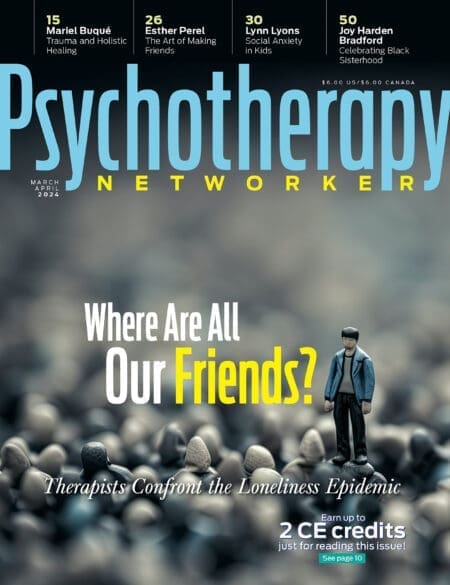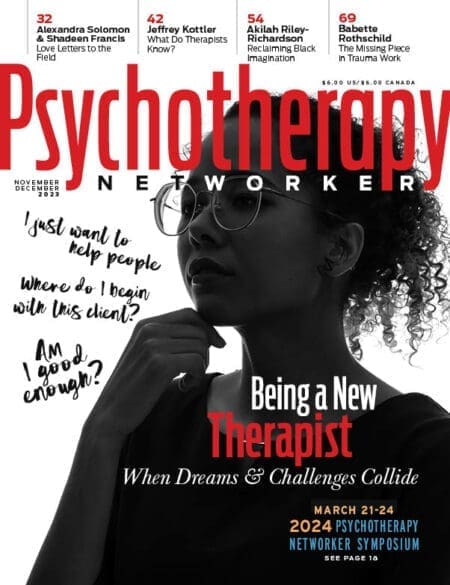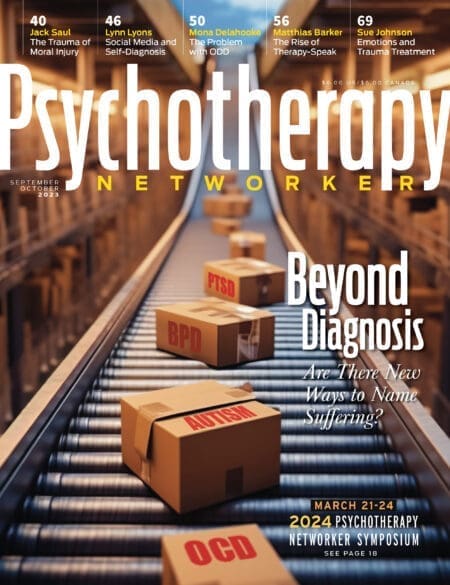COVID-19 has presented an enormous barrier to our biological need for connection. Rather than nourishing our nervous systems by being with others, we’re often on our own, behind a mask, six feet apart, feeling the profound impact of disconnection. For too many people, staying physically healthy has meant giving up important opportunities for coregulation, including deep attunement in the presence of a therapist.
For us therapists, the pandemic has brought an abrupt change in the way many of us practice. We now see clients virtually, wherever they can find a private space—in their bathrooms, bedrooms, kitchens, and cars; in their pajamas with a cup of coffee; or outside on a porch swing with a glass of wine. We might show up in the new fashion trend of a professional top combined with sweatpants. Sometimes, we might put on “real” pants and run socially distanced groups in parks and parking lots, wondering what we’ll do when winter arrives.
The work can feel draining as we try to send cues of safety across screens with unreliable internet connections and cameras that never seem to be pointed in the right place. Those of us who work from a Polyvagal Theory framework are intently trying to track our clients’ level of regulation within the three states of our autonomic nervous system: sympathetic, dorsal, and ventral. We worry that we won’t know when they’re heading into a sympathetic storm (whirling with the chaotic energy of anxiety or overwhelming anger) or disappearing into a dorsal collapse (drained of energy, losing hope, and moving out of reach). We hope they can find their anchor in ventral (feeling a flow of energy, regulated and ready to engage).
And yet, in many ways, the pandemic has shown us the incredible adaptability of our nervous systems to a new reality and the wonders of working virtually. When I first transitioned from in-person trainings to leading online workshops, I was deeply concerned about creating a sense of safety and connection for participants. Then I got this email: “Hi Deb, I was one of the many people who attended your webinar. When you finished your closing meditation, I met your gaze and felt a powerful connection, which is hard to explain because I was online with hundreds of other professionals. But in that moment, I felt I was the only one in your eyes.” This note helped me realize how even online we can offer coregulation to clients—something I never thought possible before the pandemic.
My work is centered on the critical cues of safety that I communicate from my nervous system to a client’s nervous system when I’m anchored in ventral—the state of regulation that underlies my ability to connect with curiosity and compassion. You’d think being screen to screen, rather than body to body, would hinder this coregulated way of working. But to my surprise, I’ve discovered that for many people in the polyvagal community, it’s actually enhanced their ability to be with clients and speak the language of the nervous system. In some ways, I believe it’s making all of us better therapists, helping us hone our skills not just for working online, but for when we return to working in person.
This time has been a vivid reminder to me that specific events aren’t necessarily dysregulating or traumatic; rather, it’s the way our nervous systems respond to those events that’s important to explore. Our work is to help clients be explicit about that often unnamed but critical information, which we can glean from creating autonomic maps: personalized ways of identifying the specific body sensations, feelings, behaviors, and beliefs that become active in each of our three autonomic states.
In the virtual world, these maps have taken on even greater importance. In my in-person work with my client Sara, I’d often say things like, “As you talk about that moment with your mother, where does that take you on your map?” If Sara responded, “I’m feeling my own regulation and feeling connected to you,” I’d know she was in a ventral state, and we could safely move forward with talking about the pain of their relationship. If she replied, “I’m getting a little foggy and feeling you go away,” I’d recognize she was being pulled into a place of protection, rather than connection. I’d take time to reestablish myself as a regulating presence by changing the physical distance between us—either leaning forward or sitting back or even moving to sit next to her on the couch—and adjusting my gaze and tone of voice to meet her need in the moment.
In our move to online sessions, her map was the key to making sure we could maintain enough connection to hold the work safely. At first, I was unsure how exactly to support coregulation when she needed it. So we tried several things together, and eventually we developed a menu of choices that included making eye contact with each other while saying the phrase we’re here together, putting our fingers on the screen to imagine therapeutic touch, and moving in synchrony. We also found choices that fostered self-regulation when she wanted to explore challenging moments on her own. This involved me supporting from the background by saying, “I’m here when you need me,” checking in occasionally to make sure she still felt a tether to her ventral state, and sitting back in my chair while keeping my gaze available.
A Necessary Distance
The move online has certainly been challenging, but it’s reinforced the importance of cultivating the regulating energy that comes from two nervous systems entering into autonomic intimacy—and it’s shown us that it’s possible to achieve this even when we’re not sharing the same physical space. In fact, for some clients, not sharing the same physical space seems to bring new possibilities for deeper work. Here’s an example a colleague shared with me.
“Although we’d been working together for many months in person, my first online session with my client Dan necessitated going back to therapeutic basics. We had to spend time exploring cues of safety and danger given this new virtual environment. We had to figure out how the important autonomic elements of proximity (how close to the screen we would each sit), prosody (how our microphones change the tone of our voices), and eye contact (changing the angle of cameras, turning the video off and on to regulate) were going to work.
“Even ending the session felt strange without the ritual of us walking to the door and shaking hands goodbye. The session now had to end with the push of a button, and we had to decide how that would happen without triggering emotional disconnection. Listening to the nervous system became our guide.
“A few weeks into our online work, he asked me if I’d record a message as a coregulating resource he could listen to when he felt dysregulated between sessions. This was an important turning point, as he’d come to therapy after his partner had ended their relationship because of Dan’s inability to communicate his needs and feelings. I believe working virtually made it necessary to attend to his nervous system in a more explicit and detailed way—which made him more attentive to needs and moved our work forward faster and more effectively than it would have otherwise.”
Going Deeper
Experiencing safe touch has always been critical to our well-being as humans. While the coronavirus has brought this to the fore for increasing numbers of people, touch has always been a “touchy” subject for therapists, fraught with concerns about ethics violations and boundary breaches. Nonetheless, I’ve been using safe, therapeutic touch in therapy for years and training other clinicians to do the same. Tuning in to our nervous system and allowing it to guide us through the process can be a transformative healing resource and tool for regulation.
Andrea, a therapist who participated in the last in-person workshop I led, volunteered for a demo on using self-touch and mirrored touch, techniques that don’t require physical contact with clients. Andrea had raised her hand because she was aware that integrating any form of touch in her clinical work evoked a strong sense of danger for her. Yet when we explored self-touch—with her placing her hand on her heart, her shoulder, her cheek—she discovered it was regulating and took her to an unexpected place of deep feeling. In contrast, she found mirrored touch—where the therapist engages in the same touch along with their client—mostly didn’t matter to her and was even dysregulating in some cases. For example, rubbing the fingers of one hand together was grounding as a self-touch and became annoying when mirrored. “You’re doing it wrong,” she told me. “That’s not the right way.” The moment of mirroring took her resource and turned it into a dysregulating experience.
In the end, Andrea wasn’t sure how or even if she’d use touch with her clients, but then I got an email from her with this story.
“A few months into the pandemic, a long-term client told me tearfully in a video session how much he missed touch—the simple shaking of hands, a hug between friends. I remembered our exploration and decided to take a risk with him. I’m not sure I would’ve felt safe enough to do this in person, but the computer screen gave me a sense of being connected to him while having the distance I needed to stay regulated through the discomfort of trying something new.
“When I asked my client to think about a touch that was calming or soothing, he put his hands on the sides of his face—and I mirrored him by doing the same. As he held his face for a long time, I could see his breathing slow and a sense of calm settle in. After a while he looked at me mirroring him and told me how nice that felt.
“I invited him to find another touch, but it was clear he didn’t know what to do next. Remembering that he often touched the top of his head as he talked, I invited him to try that. He put his hands on his head and laughed a bit as he recognized how familiar and regulating it felt. I mirrored him, and we stayed in that touch for a while before he began naturally to experiment with other places: touching his arm, cupping each elbow. I followed his movements without much conversation, simply traveling with him. Finally, he rested his hands on his stomach, and we stayed there for a while. He told me how surprised he was at how much more relaxed and calm he felt.
For me, the surprise was that the experience didn’t feel weird at all. I can imagine trying this when I’m working in person again.”
The Call to Listen
In my personal life, the pandemic has brought me face to face with the ways I’ve been tuning out messages my own nervous system has been trying to send me. When I ended my workday, I felt drained and numb and understood the whispered message in the background to be, “You need to change course; you’re barely holding on.” Still, I kept creating workshops and accepting invitations to lead trainings, and in a perfect example of what happens when we don’t truly listen, the messages got louder and more demanding.
After a while, I began to lose interest in the world around me. Uncharacteristically, I missed deadlines and forgot meetings. I was going through the motions of my life without being fully present in it. At that point, the message had changed to “You’ll die if you don’t do something different.” I could no longer ignore it. Finally, I found the courage to talk with my husband about the intensity of my suffering and the radical change I needed to feel alive again.
Often, change requires us to let go and take a leap. As I write this, I’m settling into a new home near my daughter and family. I’m far away from my lifelong home in Maine but exactly where I need to be to feel nourished in this moment. Before this move, my two granddaughters would appear on my computer screen many times a day. One of them even made an unexpected appearance in my online book group before I learned how to manage my computer settings.
Seeing them over video was an important part of my day, one that I told myself could satisfy my longing for family connection. Yet when I found the courage to go beneath the surface and truly listen, I discovered it wasn’t enough.
Now we’re woven into the fabric of each other’s daily lives in new ways. My calendar includes after-school pickups and soccer-practice dropoffs. We share dinner across a table, not a screen—and I’m savoring each moment. Of course, I’m awed by the way the therapeutic community has found ways to get creative across screens, but I’ve learned I also need in-person contact with loved ones to anchor in ventral. I imagine it’s the same with most people.
PHOTOS © ISTOCK/GLOBALSTOCK & ISTOCK/PROSTOCK-STUDIO
Deb Dana
Deb Dana, LCSW is a clinician and consultant specializing in working with complex trauma. She’s a consultant to the Traumatic Stress Research Consortium in the Kinsey Institute and clinical advisor to Khiron Clinics. She developed the Rhythm of Regulation Clinical Training Series and lectures internationally on ways Polyvagal Theory informs work with trauma survivors. Deb is the author of The Polyvagal Theory in Therapy: Engaging the Rhythm of Regulation, Polyvagal Exercises for Safety and Connection: 50 Client-Centered Practices, co-editor with Stephen Porges of Clinical Applications of the Polyvagal Theory: The Emergence of Polyvagal-Informed Therapies, and creator of the Polyvagal Flip Chart. rhythmofregulation.com












